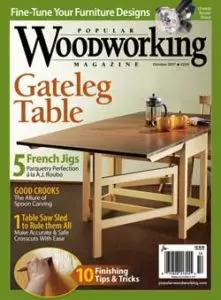 Image source: Popular Woodworking Magazine
Image source: Popular Woodworking Magazine
If you've ever stepped foot into Ikea, chances are you've encountered a gateleg table. This versatile piece of furniture has been a staple in Ikea's collection for years. But did you know that the gateleg design dates all the way back to the 18th century? In this article, we'll explore the fascinating history and construction of the gateleg table, as well as learn how to build one ourselves.
Uncovering the Origins of the Gateleg Table
When Christopher Schwarz, a renowned woodworker, stumbled upon a gateleg table at Ikea, he became curious about its origins. After conducting extensive research, he discovered that the design can be traced back to the 1700s. While some of the original tables featured intricate carvings and unique shapes, there were also simpler versions that closely resemble the ones found in Ikea today.
Schwarz was particularly enamored with the Swedish variations, which often boasted vibrant colors. Inspired by these historical pieces, he decided to create his own gateleg table based on several examples he found in auction catalogs from the late 18th and early 19th centuries. Despite its simple construction using mortise-and-tenon joints and screws, building a gateleg table requires careful measuring and marking.
Mastering the Mechanics of a Gateleg Table
At the heart of a gateleg table is a central base with two end assemblies joined by long stretchers. The base also features two "gates" that are hinged to the legs, allowing them to swing out and support the drop leaves when in use. The drop leaves themselves are connected to the top of the base with strap hinges, while battens screwed to the underside of each leaf keep them flat and rigid.
Although the base and gates may seem deceptively simple, proper joinery is crucial for stability. Schwarz opted for drawbored mortise-and-tenon joints, known for their strength and durability. By cutting mortises with a hollow-chisel mortiser and tenons with a dado stack in a table saw, Schwarz ensured precise and accurate joinery.
Crafting the Gateleg Table: Layout, Mortising, and Assembly
To begin the construction process, Schwarz recommends preparing the stock for the base and gates. By cutting the tenons first and using them as guides to mark out the mortises, he minimized measuring errors. He also emphasized the importance of testing the fit of each tenon with a sample mortise in scrap wood.
Once the joinery is all cut, it's time to focus on clean-up and drawboring. Schwarz suggests drilling the holes for the pegs through each mortise before removing machine marks. Drawboring, a technique where holes are slightly offset from the tenon's center, creates a mechanical lock that enhances the joint's strength.
After drawboring, the gates can be assembled, ensuring a proper fit between the stiles and stretchers. Then, it's time to hinge the gates to the base, a step that requires precision and attention to detail. By carefully knifing where the hinges should go on each leg and using ramped mortises, the gates can swing freely without any binding.
Completing the Gateleg Table: Tops, Dropleafs, and Finishing Touches
With the base and gates assembled, the next step is to install the top of the table. Schwarz recommends centering the top on the base and using shop-made wood buttons to join them while allowing for wood movement. By making six table buttons and screwing them to the underside of the top, the base and top become securely connected.
To add functionality and flexibility, dropleafs can be installed. After gluing up the dropleafs and cutting them to their final size, they are positioned between the tops, clamped in place, and secured with strap hinges. Battens are then added to prevent cupping and provide rigidity to each dropleaf.
To achieve a beautiful finish, Schwarz suggests using General Finishes Milk Paint for the base and gates, and shellac followed by an oil/wax blend for the tops. The result is a stunning table that seamlessly combines historical charm with modern aesthetics.
Unlocking the Timeless Appeal of the Gateleg Table
The gateleg table is more than just a piece of furniture – it's a testament to the enduring nature of design. With its ability to adapt to various spaces and accommodate different occasions, this table is a true classic that transcends time. So, whether you're a woodworking enthusiast or simply looking for a versatile and stylish addition to your home, consider the gateleg table – a contemporary-looking design that's deeply rooted in history.
Note: This article is based on the original piece by Christopher Schwarz from Popular Woodworking Magazine, October 2017.

















